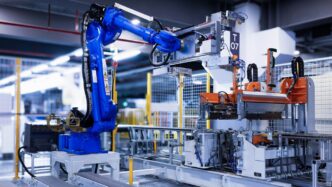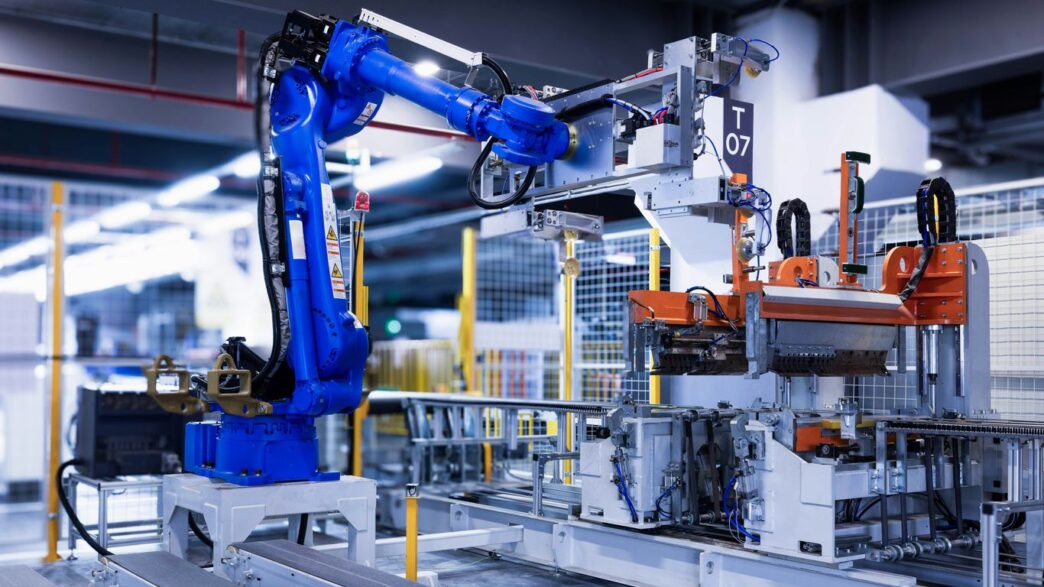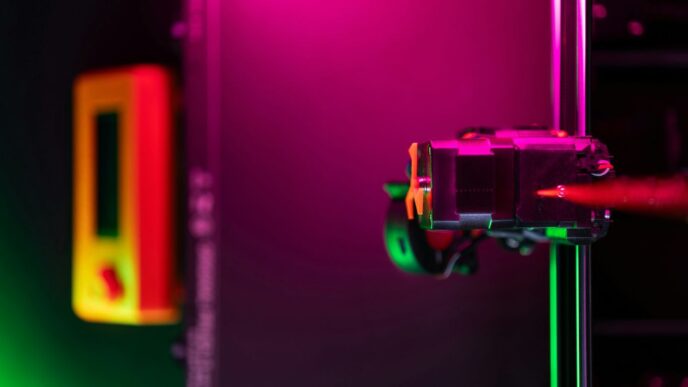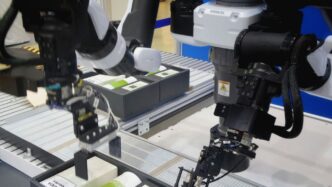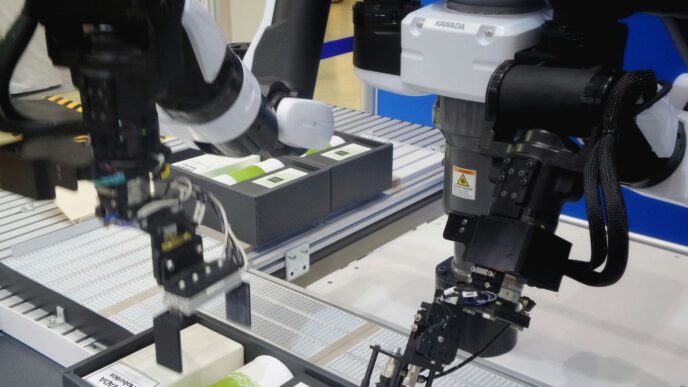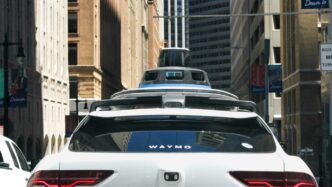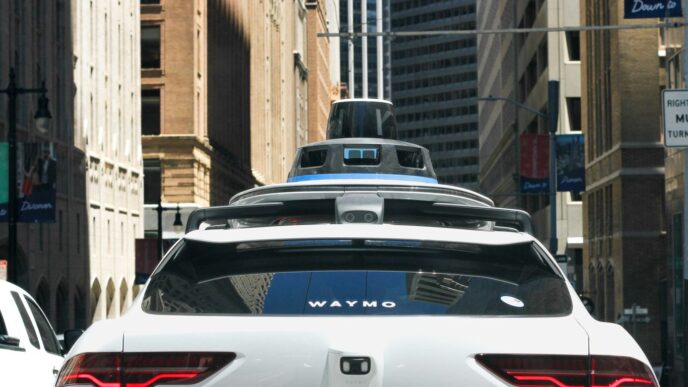Giants Shaping The Biggest Robotics Companies Landscape
When we talk about the biggest names in robotics for 2025, a few companies immediately come to mind. These are the established players, the ones who have been around for a while and have really built up their reputations and their product lines. They’re not just making robots; they’re shaping how industries work and how we think about automation.
ABB: Driving Automation Forward
ABB is a name you’ll hear a lot in the automation world. They’ve been a major force for ages, especially in industrial robotics. Think factories, car manufacturing, electronics assembly – ABB robots are often the ones doing the heavy lifting and precise work. They’re really good at making robots that can handle tough jobs and work reliably day in and day out. Their focus is on making automation accessible and efficient for a wide range of businesses. They also have a strong push into collaborative robots, or cobots, which are designed to work safely alongside humans. It’s all about making factories smarter and more productive.
Fanuc Corporation: Industrial Automation Powerhouse
Fanuc is another giant, and they’re based in Japan. They are incredibly well-known for their industrial robots, particularly in the automotive sector. If you’ve ever seen a car being built, chances are a Fanuc robot was involved somewhere along the line. They have a massive range of robots, from big, powerful ones for heavy-duty tasks to smaller, more precise ones for delicate assembly. What sets them apart is their deep technical know-how and their commitment to quality. They also invest a lot in AI and vision systems to make their robots smarter and more adaptable to different tasks. It’s this dedication to robust engineering that keeps them at the top.
KUKA AG: Pioneering Robotic Solutions
KUKA, a German company, is also a big player, especially in Europe and North America. They’re known for their distinctive orange robots that you see in many factories. KUKA makes robots for all sorts of applications, from welding and assembly to palletizing and handling. They’ve been pushing the boundaries with their innovations, like developing robots that can work in more complex environments and handle a wider variety of tasks. They also have a strong focus on software and digital solutions, aiming to make their robots easier to integrate and manage within a larger automated system. Their work is really about making robots more versatile and user-friendly.
Innovators Redefining Robotics Capabilities
It feels like every week there’s some new company pushing the boundaries of what robots can do. We’re not just talking about factory arms anymore; these innovators are building robots that can walk, think, and interact in ways we used to only see in movies. It’s pretty wild to see how fast things are moving.
Boston Dynamics: Advanced Mobility and Humanoids
Boston Dynamics has been turning heads for years with robots that move like animals. Their quadruped robot, Spot, is probably the most famous, zipping around construction sites and even dancing. But they’re also making big strides with their humanoid robot, Atlas. Atlas is getting seriously good at complex physical tasks, showing off incredible balance and agility. It’s not just about walking; it’s about performing dynamic movements that are incredibly hard for machines. They’re really focused on making robots that can handle tough, real-world environments where humans might struggle.
NVIDIA: AI Foundation for Next-Gen Robots
NVIDIA might be known for its graphics cards, but they’re becoming a huge player in robotics too. They’re building the brains behind the next generation of robots. Their Project GR00T, announced in early 2024, is all about creating general-purpose AI models for humanoid robots. The idea is that these robots can learn from watching us, understand what we say, and figure out how to do things in messy, unpredictable places. Think of it as giving robots a more human-like way to learn and adapt. They’re also developing simulation tools, like LucidSim, which helps train robots in virtual worlds before they hit the real one. This makes training faster and robots more capable.
Sanctuary AI: Humanoid Dexterity and Learning
Sanctuary AI is another company focused on humanoids, but with a specific emphasis on making them useful in everyday tasks. Their robot, Phoenix, is designed to be incredibly dexterous, meaning it can handle objects and perform tasks with a level of skill that’s pretty close to human. They’re integrating advanced AI, including large language models, so these robots can understand instructions and learn new tasks quickly. The goal is to create robots that can work alongside people in places like warehouses, retail, and even homes, helping to fill labor gaps and take on repetitive or difficult jobs.
Key Players in Specialized Robotics Sectors
While the big names like ABB and Fanuc get a lot of attention for their industrial might, there are some really interesting companies carving out their own space in specific areas of robotics. These guys aren’t just building robots; they’re creating specialized tools that are changing how we approach everything from surgery to farming.
Intuitive Surgical: Advancing Medical Robotics
When you think about robots in medicine, Intuitive Surgical is probably the first company that comes to mind, and for good reason. Their da Vinci Surgical System has pretty much revolutionized minimally invasive surgery. It’s not like the surgeon is just pushing buttons on a screen; they’re actually controlling robotic arms with incredible precision. This means smaller incisions, less pain for patients, and often quicker recovery times. They’re constantly working on making the system even more capable, adding features that give surgeons better sight and control during complex procedures. It’s a pretty amazing example of how robotics can directly improve human health.
DeLaval: Robotics in Agriculture
Farming might seem like a traditional industry, but it’s actually a hotbed for robotics right now, and DeLaval is a major player here. They’re known for their automated milking systems. Imagine cows being able to go to a milking station whenever they feel like it, and the robot just handles the rest. This not only makes life easier for farmers by reducing manual labor but also helps keep the cows healthier and happier. DeLaval is also looking into other areas, like automated feeding and cleaning systems, to make running a farm more efficient and sustainable. It’s all about using technology to get more done with less effort and better results.
DJI: Dominance in Drone Technology
DJI has become almost synonymous with drones. They started out making drones for hobbyists, but they’ve really expanded into professional use cases. Think about everything from aerial photography and filmmaking to inspecting infrastructure like bridges and power lines, or even helping with agricultural surveys. Their drones are known for being stable, easy to fly, and packed with advanced features like obstacle avoidance and high-quality cameras. DJI’s ability to pack so much technology into relatively affordable and user-friendly packages has made them the go-to brand for a huge range of applications. They’re really setting the pace for what’s possible with unmanned aerial vehicles.
Emerging Forces and Investment Trends
It’s pretty wild to see how many new players are popping up in the robotics scene. A lot of this energy is coming from smart investments and government backing, which is really shaking things up. We’re seeing a big push, especially in places like Asia and the Middle East, to get more automation going.
One of the big drivers right now is how easy it’s becoming to program robots. Think about it: platforms that let you set up robots with less coding are starting to show up everywhere. This is a game-changer, especially for smaller businesses that don’t have a ton of tech experts on staff.
Governments are also throwing money at this. The US, for example, has the CHIPS Act, which is putting a lot of cash into factories that use advanced robots. Europe is doing something similar with its recovery fund, and Japan is giving tax breaks for companies that invest in collaborative robots. It’s like they’re all realizing how important this stuff is for the future.
But it’s not all smooth sailing. There’s still a big gap when it comes to small and medium-sized businesses actually knowing how to use these robots. A lot of the experts are in big cities, leaving other areas behind. Plus, there are some trade issues, like export controls on certain robot parts, that are making things more expensive and slowing down how fast companies can get new robots up and running. It’s a bit of a balancing act, for sure.
Standard Bots: AI-Native Control Stacks
Standard Bots is really focusing on making robots smarter from the ground up. They’re building control systems that are designed with artificial intelligence right in the middle of it all. This means robots could potentially learn and adapt much faster than before, which is a pretty big deal for making automation more flexible.
Figure AI: High-Valuation Robotics Ventures
Figure AI has been making waves, and not just for their tech, but for the huge amount of money they’ve managed to raise. This kind of investment shows that people with money really believe in the future of advanced robots, especially those that can do more human-like tasks. It’s a sign that the industry is maturing when startups can pull in that kind of funding.
RLWRLD and Unitree Robotics: Startup Momentum
Keep an eye on companies like RLWRLD and Unitree Robotics. They’re part of a wave of newer companies that are gaining traction. Unitree, for example, has been known for its agile quadruped robots, showing off impressive movement capabilities. These startups are often quicker to adopt new ideas and can push the boundaries in specific areas, adding to the overall innovation in the field.
Strategic Moves by Established Leaders
Big names in robotics aren’t just sitting back and watching the industry change; they’re actively making moves to stay ahead. It’s a bit like a chess game, really, with each company trying to position itself for the future. Some are looking to shake things up by spinning off parts of their business, while others are focusing on strengthening their existing market position.
ABB’s Robotics Division Spin-Off
ABB is making a pretty significant change by planning to separate its robotics division. This move is expected to give them more freedom to invest in new areas, especially in AI software. Think of it as freeing up resources to chase after the next big thing. Their robotics division brought in about $2.3 billion in revenue in 2024, so it’s a substantial part of their business. This separation could mean more flexibility for acquisitions and strategic partnerships in the fast-moving AI space.
Yaskawa Electric Corporation’s Market Presence
Yaskawa is a company that’s been around for a while, and they’re known for their strong presence in industrial automation. They’ve got a solid grip on various markets, especially with their servo technology. While they might not be making splashy headlines with spin-offs, they’re busy strengthening their core business. This often involves improving their existing product lines and expanding their service networks to keep their customers happy and loyal. It’s a steady approach, building on what they do best.
Mitsubishi Electric’s Automation Integration
Mitsubishi Electric is taking a different tack, focusing on bringing different parts of automation together. They’re working on integrating various systems and technologies to offer more complete solutions to their clients. This means their robots aren’t just standalone machines; they’re becoming part of a larger, smarter automated process. This kind of integration is key for factories and businesses that want to streamline operations and get more out of their automation investments. It’s about making everything work together more smoothly.
Defense and Ruggedized Systems
When we talk about robots getting tough, the defense sector is a big player. It’s not just about making robots that can handle rough environments, but also about creating systems that can perform critical tasks where human safety is a concern. Think about counter-drone technology or robots used in hazardous zones. These aren’t your typical factory floor machines; they need to be robust, reliable, and often, quite sophisticated.
Anduril: Counter-Drone Solutions
Anduril is a company that’s really making waves in this space. They’re known for their work in defense technology, and a big part of that is their focus on counter-drone systems. It’s a pretty complex problem, right? You’ve got these small, often fast-moving drones that can pose a threat, and you need a way to detect and deal with them. Anduril is developing integrated systems that combine hardware and software to tackle this. They’ve landed some significant contracts, like a multi-year deal with the U.S. Navy for counter-drone work. This shows that governments are really investing in these kinds of advanced robotic solutions for security.
DARPA’s RACER Program
Then there’s DARPA, the Defense Advanced Research Projects Agency. They’re always looking ahead, funding projects that could change the game. The RACER program is a good example. It’s all about developing robotic vehicles that can operate at high speeds in off-road conditions. The goal isn’t just to make a fast vehicle, but to create robots that can keep up with or even outmaneuver human-driven vehicles in challenging terrains. This kind of research pushes the boundaries of what robots can do, especially in terms of mobility and control. It’s a long-term play, but the kind of tech that comes out of these programs often finds its way into other areas too.
The Road Ahead for Robotics
So, what does all this mean for the future? It’s pretty clear that robots aren’t just science fiction anymore; they’re becoming a normal part of how we work and live. Companies like ABB, FANUC, and KUKA are still big players, but there’s a whole new wave of startups, often backed by serious cash, focusing on smart software and AI. We’re seeing robots get better at learning, adapting, and doing more complex jobs, especially in warehouses and factories. While North America is leading the charge right now, Asia is catching up fast. It’s going to be interesting to see how all these different companies and technologies shake out, but one thing’s for sure: automation is here to stay and it’s only going to get more advanced.

